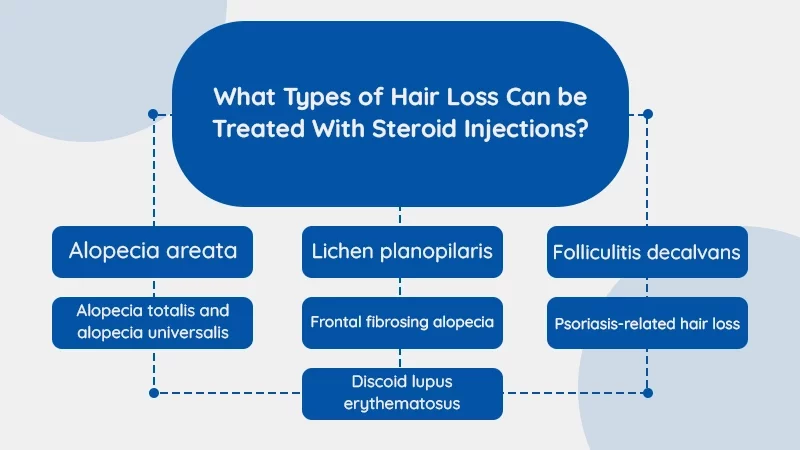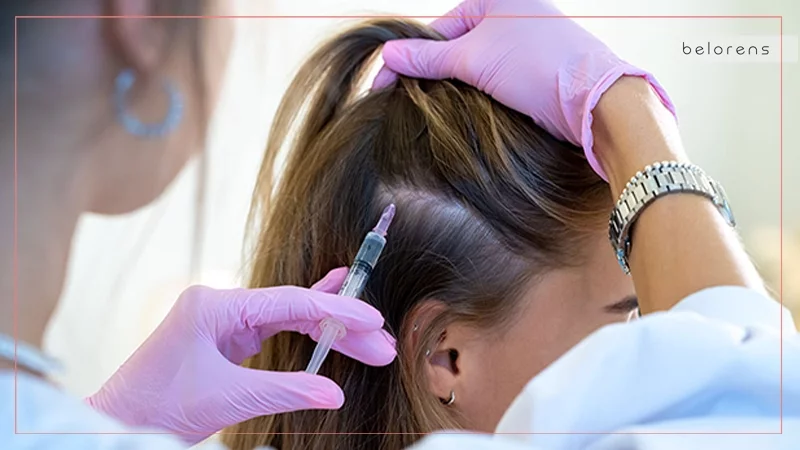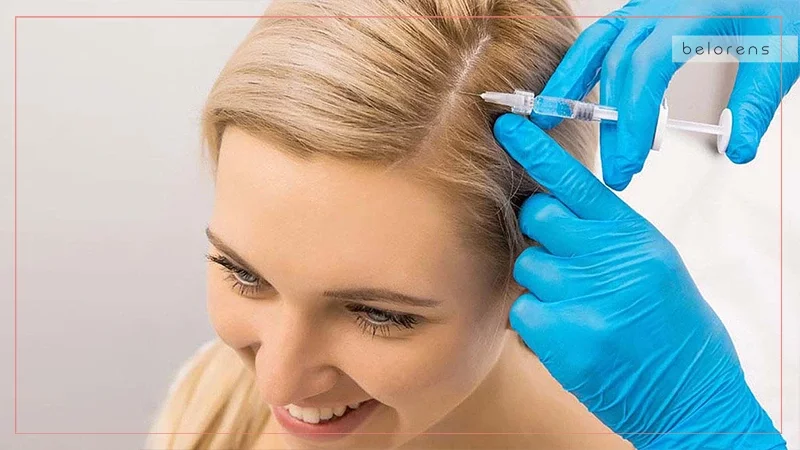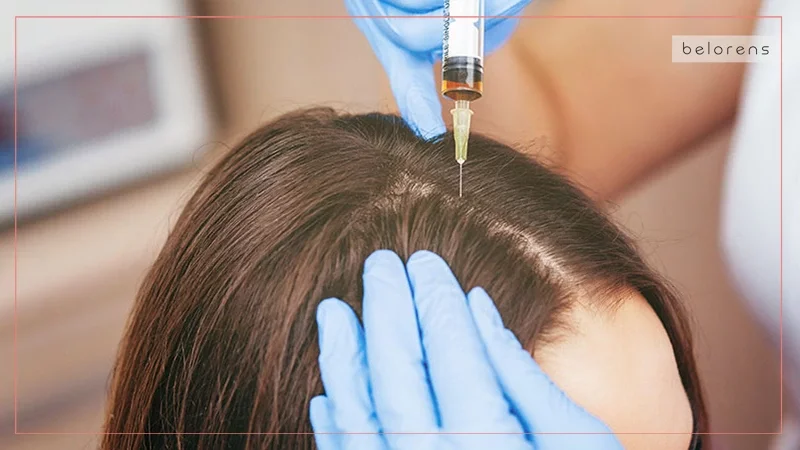Published on 22 Sep 2024
Steroid Injections for Hair Loss: How They Work and What to Expect
- ByMedical Content Team
- Medically Reviewed byDr. Sabine Kulhanek
Fact checked

- What are steroids?
- How does a steroid injection work to treat hair loss?
- Who can benefit from steroid injections?
- What types of hair loss can't steroid injections address?
- How are steroid injections for hair loss performed?
- What is the recovery like?
- Are there any risks associated with steroid injections?
- How much do steroid injections cost?
- Are steroid injections effective?
- FAQs
Hair loss is a common concern that affects millions of people worldwide, impacting their confidence and overall quality of life. While various treatments are available, from topical solutions to oral medications, steroid injections have emerged as a notable option for those seeking effective results. This blog post delves into the use of steroid injections for hair loss, exploring how they work, their benefits, potential side effects, and what to expect during treatment. Whether you're experiencing thinning hair or more significant hair loss, understanding this treatment can help you make an informed decision on your journey to healthier hair.
What are steroids?
Steroids, or corticosteroids, are synthetic drugs designed to mimic the effects of hormones produced naturally by the adrenal glands, which are located atop the kidneys. These hormones play crucial roles in regulating various bodily functions, including inflammation, immune response, and metabolism. There are two main types of steroids used in medical treatments: anabolic steroids and corticosteroids.
- Anabolic Steroids: These are synthetic variations of testosterone, the male sex hormone. They are often used to promote muscle growth and enhance physical performance. While anabolic steroids can be beneficial in specific medical scenarios, they are not used for hair loss treatments due to their different mechanisms of action and potential side effects.
- Corticosteroids: These steroids are similar to cortisol, a hormone that helps the body respond to stress, reduce inflammation, and regulate the immune system. Corticosteroids are commonly used to treat a variety of conditions, including allergies, asthma, arthritis, and skin disorders. For hair loss, corticosteroids are employed to combat inflammation that can damage hair follicles, thereby promoting hair regrowth.
How does a steroid injection work to treat hair loss?
When used for hair loss, corticosteroids are typically administered through injections directly into the scalp. This localized treatment targets areas where hair is thinning or balding, reducing inflammation and potentially stimulating hair follicles to resume normal hair production.
Hair loss conditions like alopecia areata are often driven by inflammation that damages hair follicles. Corticosteroids are powerful anti-inflammatory agents that help reduce this inflammation. By injecting steroids directly into the affected areas of the scalp, the localized treatment targets and diminishes inflammation around the hair follicles, creating a more favorable environment for hair growth.
Steroid injections work by modulating the immune system's response, suppressing the autoimmune activity that causes hair follicle damage. This immunosuppression can help halt hair loss and allow the follicles to recover and start producing hair again.
Who can benefit from steroid injections?

Steroid injections, particularly corticosteroid injections, are effective for treating certain types of hair loss that involve inflammation or autoimmune responses. They work by reducing inflammation, modulating the immune system, and creating a more favorable environment for hair regrowth. Here are the primary types of hair loss that can be addressed with steroid injections:
Alopecia areata
Alopecia areata is an autoimmune disorder where the immune system attacks hair follicles, leading to patchy hair loss on the scalp and other areas of the body. Steroid injections can reduce inflammation and suppress the immune response, promoting hair regrowth in affected areas.
Alopecia totalis and alopecia universalis
These are more severe forms of alopecia areata. Alopecia totalis results in complete scalp hair loss, while alopecia universalis causes the loss of all body hair. Steroid injections can help in some cases by reducing the immune system's attack on hair follicles and encouraging hair regrowth, though results can vary.
Lichen planopilaris
Lichen planopilaris is a rare inflammatory condition that causes scarring and hair loss on the scalp. Steroid injections can help reduce inflammation and slow down the progression of the disease, preventing further hair loss and, in some cases, promoting regrowth in less damaged follicles.
Frontal fibrosing alopecia
This condition is a subtype of lichen planopilaris that primarily affects the front and sides of the scalp, leading to progressive hair loss. Steroid injections can help manage inflammation and slow down hair loss, although they are not always effective in reversing the condition.
Discoid lupus erythematosus
Discoid lupus erythematosus is a chronic autoimmune condition that affects the skin, including the scalp, leading to scarring and hair loss. Steroid injections can reduce inflammation and immune activity, helping to manage symptoms and promote hair regrowth in some cases.
Folliculitis decalvans
Folliculitis decalvans is a rare, chronic inflammatory condition that results in scarring hair loss. Steroid injections can help control inflammation and slow the progression of hair loss, providing relief from symptoms and potentially aiding in hair regrowth.
Psoriasis-related hair loss
Scalp psoriasis can cause hair loss due to the inflammation and scaling associated with the condition. Steroid injections can help reduce inflammation and improve the health of hair follicles, promoting hair regrowth.
What types of hair loss can't steroid injections address?

While steroid injections can be effective for treating certain types of hair loss, they are not suitable for all conditions. Here are some types of hair loss that steroid injections generally cannot address:
Androgenetic alopecia (male and female pattern baldness)
Androgenetic alopecia, commonly known as male or female pattern baldness, is the most prevalent form of hair loss. It is primarily caused by genetic factors and the influence of androgens (male hormones). Steroid injections are not effective for this type of hair loss because it is not driven by inflammation or autoimmune responses but by genetic predisposition and hormonal changes.
Telogen effluvium
Telogen effluvium is a temporary form of hair loss that occurs when a large number of hair follicles enter the resting phase (telogen) simultaneously. This condition is often triggered by stress, illness, hormonal changes, or certain medications. Since telogen effluvium is typically a temporary and self-resolving condition, steroid injections are not a standard treatment as the underlying cause is not related to inflammation.
Trichotillomania
Trichotillomania is a psychological disorder characterized by an irresistible urge to pull out one's hair, leading to hair loss. Steroid injections are not suitable for treating trichotillomania because the condition is behavioral and psychological in nature, requiring therapeutic interventions such as cognitive-behavioral therapy (CBT) rather than medical treatments targeting inflammation.
Scarring alopecia
Scarring alopecia, or cicatricial alopecia, refers to a group of rare disorders that destroy hair follicles and replace them with scar tissue, leading to permanent hair loss. Although some inflammatory forms of scarring alopecia might initially respond to steroid injections, the overall effectiveness is limited due to the permanent damage to hair follicles. More advanced treatments, such as immunosuppressive medications or surgical options, might be required.
Chemotherapy-induced hair loss
Hair loss caused by chemotherapy, known as anagen effluvium, occurs because the treatment targets rapidly dividing cells, including hair follicles. Steroid injections do not address chemotherapy-induced hair loss, as the mechanism involves direct damage to the hair follicles from chemotherapy drugs rather than inflammation or autoimmune activity.
Nutritional deficiencies
Hair loss due to nutritional deficiencies, such as a lack of iron, zinc, or vitamins, cannot be effectively treated with steroid injections. Addressing this type of hair loss requires correcting the nutritional imbalance through diet or supplements rather than reducing inflammation.
Also Read: How to Treat Hair Loss in Women
Understanding the limitations of steroid injections for hair loss is crucial for setting realistic expectations and pursuing the most appropriate treatment options for your specific condition. Consulting with a dermatologist or hair loss specialist can help determine the best course of action based on the underlying cause of your hair loss.
How are steroid injections for hair loss performed?

Steroid injections are very easy to perform and don’t require much time. They do not even require anesthesia and can be easily performed in a doctor’s office. The steps of the procedure are as follows:
- The practitioner uses antiseptic to clean the skin of your scalp or any other required place.
- They draw about 3ml of corticosteroid (triamcinolone acetonide solution) in a small syringe and use a very small (30 gauge) needle for injection.
- Then the practitioner injects about 0.1 to 0.2 mL of solution roughly 1 cm apart.
- Depending upon the size of the patch, the doctor repeats the process to cover the entire area. For example, a 5 x 5cm patch may require 10 to 15 small injections.
Overall, the skin patch may require as few as two injections to as many as 80 or even 90 during one session. There is only slight discomfort, that too very short-lived. That is why it does not require anesthesia. However, your doctor can also use topical anesthesia to reduce pain.
What is the recovery like?
Steroid injections for hair loss is a nonsurgical procedure -- meaning it does not involve any significant incision. As a result, the recovery is fairly quick and is free of any significant side effects caused by the procedure.
As for the results, you may not notice any improvement in your hair for a month or more. It not only takes time for the injection to suppress inflammation or the immune system, but the new follicles also take time to grow into healthy hair. For example, in one study involving 101 people with Alopecia Areata, 80.2 percent of the participants saw an improvement in their hair growth in a median time of 3.2 months.
Furthermore, you will need two to three such sessions every four to six weeks to maintain the effects of the steroid on the immune system. So consult your doctor to discuss more about the recovery and if you are a candidate for this treatment option.
Are there any risks associated with steroid injections?

Some of the risks of steroid injections include:
- Small bleeding points at the injection sites
- Discomfort, soreness, or pain, which usually resolves within hours
- Mild headache, which goes away on its own or with common medication
- Thinner, paler, and more wrinkled skin in the weeks following the injections. But these problems, too, go away with time
- Acne, pimples, or rashes may appear in the treated area
- The face may become red or puffy
- Steroid medication may get absorbed into the bloodstream, causing systemic side effects
While these side effects are uncommon, it is important to know that steroid injections are required every four to six weeks, and in the long run, you may begin to experience other side effects such as bone thinning, high blood pressure, vision problems, menstrual cycle disturbances and a temporary reduction in immune functions.
How much do steroid injections cost?
The cost of getting steroid injections for hair loss varies significantly from place to place and the experience of your doctor. Typically, a corticosteroid injection for alopecia areata can cost $25 to $100 or more per session. Thus, two to three sessions of steroid injections may cost anywhere between $200 to over $1000. However, the good news is the cost is less than other treatment options, such as oral or topical medications, PRP, and hair transplants.
Are steroid injections effective?
Steroid injections effectively treat patchy hair loss caused by chronic inflammation or auto-immune conditions. Doctors have successfully treated people with alopecia areata with the corticosteroid triamcinolone acetonide for over 50 years now. As a result, plenty of evidence supports using steroid injections for hair loss. For example, a 2009 study published in the Journal of Drugs in Dermatology showed that intralesional triamcinolone acetonide is a safe and effective treatment for patients with extensive alopecia areata.
The authors of a 2015 study compared the effects of cryotherapy and steroid injections and found steroid injections to be more effective at treating alopecia areata. Similarly, a 2022 study suggests that steroid injections are safe and effective in treating severe or active alopecia areata. Likewise, the literature is also consistent with steroid injections for the treatment of other inflammatory and auto-immune causes of hair loss, such as lichen planopilaris.
Thus, steroid injections are an effective yet inexpensive and relatively safe way of treating patchy hair loss. However, it’s crucial to talk to a dermatologist for a thorough consultation. They not only provide in-depth information about the process but also recommend the procedure that would best suit your needs.
Also Read: Do Energy Drinks Cause Hair Loss?
FAQs
Are steroid injections better than topical or oral steroids?
Yes, steroid injections have fewer side effects than topical steroids, far less than oral. In addition, steroid injections cost less than topical or oral steroids. Furthermore, some oral medications for treating alopecia areata can cost even more than steroids. For example, the first FDA-approved systemic treatment for severe alopecia areata: the oral tablet baricitinib (Olumiant), costs around $2500 to $5000 per month.
Does insurance cover steroid injections for hair loss?
No. Unfortunately, many insurance companies consider hair loss treatments cosmetic procedures, not medical necessities. So insurance might not cover the treatment for these types of hair loss. For example, a multi-institution retrospective review found the insurance coverage denial rate to be 97 percent. However, talk to your insurance provider to see if they cover the treatment expenses for your condition.
When should I get steroid injections?
You should get steroid injections within the first month of developing a patch of alopecia areata. It will help quieten the immune system and prevent further increases in the patch size. However, you can get a steroid injection whenever you feel comfortable.



